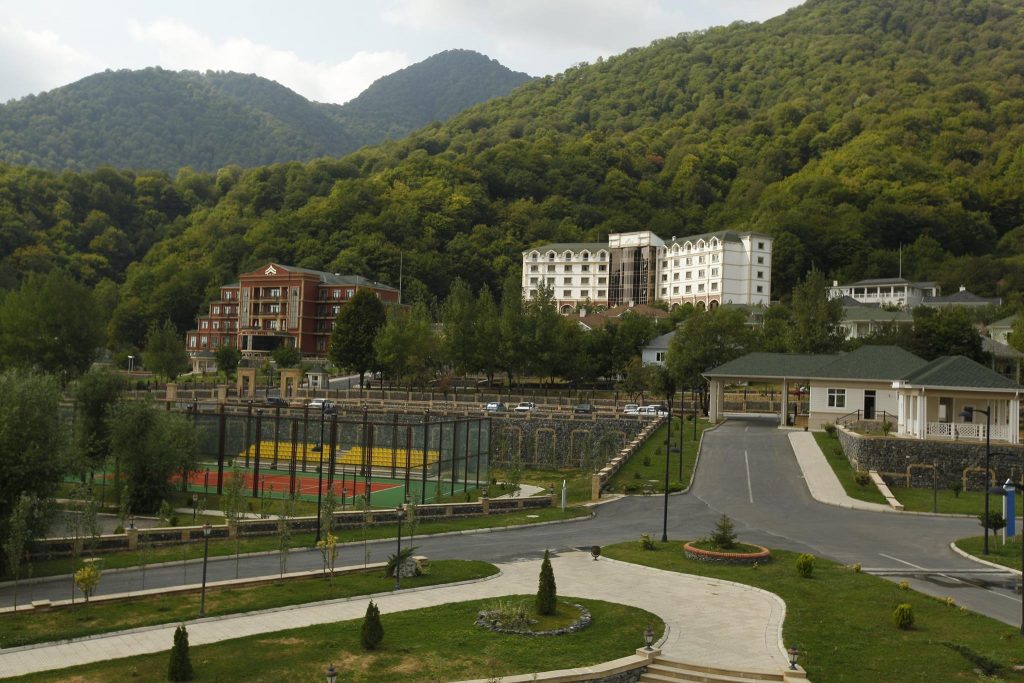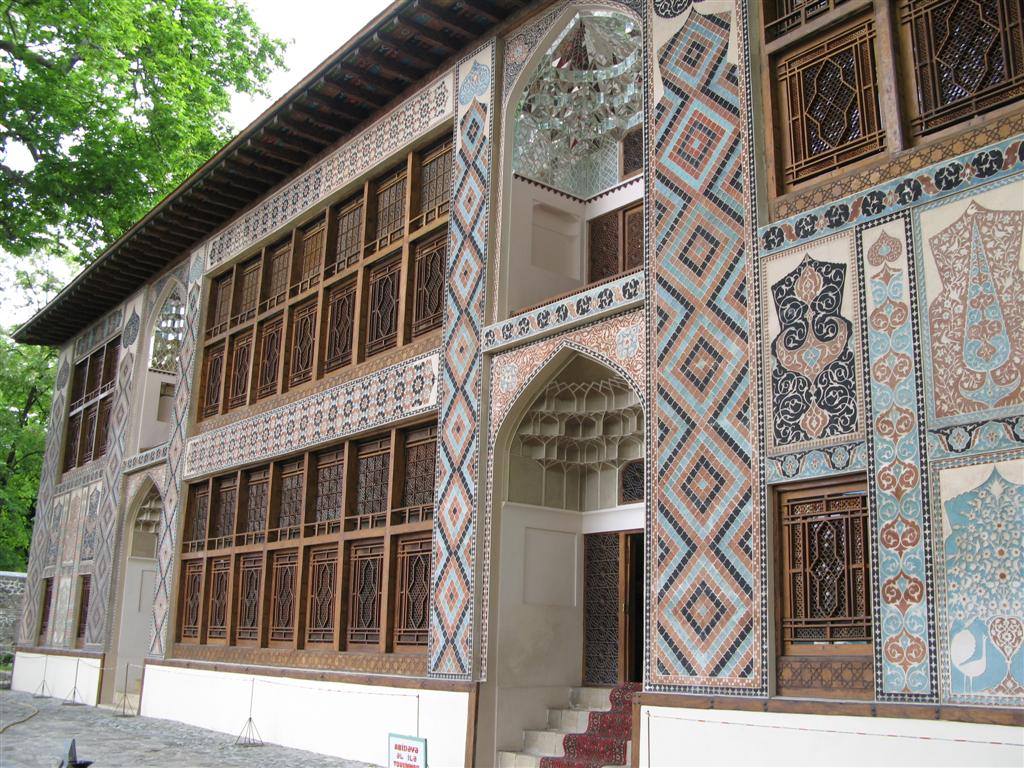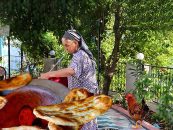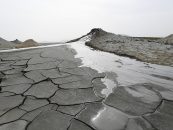Azerbaijan has a very favorable geographical position. Situated on the crossroads between West and East, it is surrounded by mountains on three sides and abutting on the Caspian Sea on the fourth side. The nature itself has taken care of our country by surrounding it with its majestic and unapproachable mountains known as the Greater and Small Caucasus range, and Talysh Mountains. And, at the same time, it has presented us with the biggest salty lake in the world, as the Caspian Sea is nothing but a lake…
The nature has also taken care of the country’s climatic conditions. Can you imagine 9 out of 11 climatic zones existing on our planet that are found in the territory of Azerbaijan? It really is a “Heavenly gift”! Found here is a wide variety of vegetation and animal species, some of which are very rare and already extinct in other parts of the world.
Azerbaijan has unique landscapes that allow for development and expansion of the tourism industry. Those desiring to take rest in our country will be offered opportunities to relax up in the mountains in Winter and Summer, breathe in a clean mountain air, enjoy extreme winter activities and mountain sports, drink cold water from mountain springs and admire the waterfalls, bask on the golden sand beaches of Apsheron in Summer, visit national parks, walk in an old-growth tertiary forest, feel the air of ‘pristine antiquity,’ eyewitness ancient customs and traditions of different ethnic groups living in Azerbaijan from times immemorial, hear their songs and see them dance and, at the same time, taste the most delicious and unique dishes from all regions of the country…
As evidenced by history, Azerbaijanis are a peace-loving and friendly people. For centuries, it was populated by a hundred different nationalities, professing different religions that have never fought on national or religious grounds. Azerbaijan is a tolerant country. We are happy to accept foreigners that come to us with peace… The Azerbaijani people is friendly and hospitable. To eyewitness this, one has to come and visit with us… We always welcome friends!
Khynalyg.
Remote and impenetrable mountain areas of Azerbaijan have, since ancient times, been populated by peoples with a distinctive identity and local dialect that is very different from Azerbaijani language. We can only guess how and when these peoples came here… However, having adapted to austere mountain conditions, they do not seem to lose heart…
One of such ancient mountain settlements, Khynalyg, is situated on the slope of Kyzylkaya mountain, at the altitude over two thousand meters above sea level, in Guba region of Azerbaijan (the Greater Caucasus range). It is famous for its unique customs and traditions. Currently, Khynalyg is populated by about two thousand people. Most of its population comprises indigenous people.
The inaccessibility, language, unique architectural style and culture of the village attract tourists and travelers. Here, one can find a Temple of fire worshippers, the tomb of Hydyra Nebi, the mosque of Sheikh Shalbuz and Abu Muslim, build in the middle Ages, caves and numerous unexplored archaeological sites.
Prior to the Islamic faith, the inhabitants of Khynalyg were Zoroastrians. They are still treating fire with special awe in our days. To the West of Khynalyg, there is a place where natural gas comes from the ground, called the ‘place where the fire burns.’
People living here are descendants of Caucasian Albanians, who inhabited a country that ceased existing in about 5th century AD. To reach this mountainous hamlet one should first go to Guba that is the county town situated in the northernmost part of Azerbaijan.
At present, Khynalyg is not isolated from the world anymore, although it is still a unique place. Special attention should be paid to the road that leads up to the hamlet.
Whereas in time past mountainous villagers only made use of pack animals like horses and mules, nowadays Khynalyg is connected with a motor way that spirals in between mountains, lurking through rifts and passing by the river.
The residents of Hynalyg call their village Katom. They call themselves Katas – direct descendants of Noah from the Bible. The first mention of Katas was made by Pliny, the ancient Roman historian that lived in the 1st century AD, as well as by Strabo’s famous work Geographica. But the ancient history of the village is most eloquently evidenced by its 8 large graveyards, whose area is by far exceeding that of Khynalyg itself. There are 3 to 4 layers of buried human residues here, and gravestone inscriptions have used different alphabets.
Katas build houses on top of other houses that made them resemble multistoried buildings. The roof of lower houses is used as a yard by upper stores. The village comprises about 360 houses that are 200 to 300 years old, and made of pebble stones. The ceiling in many houses has a smoke hole used by many villagers to visit each other. On the inside, floors and walls are covered with multicolored thick woven carpets and blankets, pillows, poufs, and woven “markka.” They do not only embellish homes but protect them from cold winter weather. This place is known for early and severe winters, when temperature can go down to -30⁰ С.
Their land is unfertile and rocky but local people manage to grow onions and potatoes at small parcels of land, and use vats to grow cucumbers and tomatoes, like house plants, in their homes. Their cattle consist of short cows and goats as well as poultry.
Azerbaijan’s President Ilham Aliyev has issued a decree, 19 December 2007, whereby the historic area of Khynalyg was declared to be the State Historical, Architectural and Ethnographic Reserve titled “Khynalyg.”
LAGHYJ
Laghij is one of the most renowned – both in and outside Caucasian region – trade and handicraft centers whose famous production of cold steel arms and brass homeware engraved with ornament dates back to the Middle Ages. This settlement is mostly populated by the laghits.
The settlement is situated on the left bank of Girdimchay river, at the altitude of 1375 meters above the sea level. The river springs from the slopes of the Greater Caucasus peak called Babadag found to the north of Laghij.
As the State Historical and Cultural Reserve of 15 – 19th centuries, Laghij was included in the international tourist route titled “the Great Silk Way.”
Laghij is a beautiful place that attracts tourists coming from everywhere. Its major street, somewhat resembles the Torgovaya Street in Baku, consists of the shops owned by local craftsmen and nearby craftshops that produce handiwork. This street is known for its leather-dressers, weavers and coppersmiths. Souveniers they produce are known for their exquisite beauty and expensive prices that are caused by recent visits of foreign citizens to Laghij…
This has caused an increased demand for local masters’ handiwork. Well, it is a pleasure to know that our masters’ handiwork travel to many countries to please aesthetic people throughout the world…
Embodying the principle of quarter development, Laghij represents an original medievil memorial of urban planning and architectural art with paved streets and squares, well-developed sewage and water supply systems. Purportedly, local sewage system is about 1000 years old. All buildings were made of stone with timber.
There are a few popular legends about the origin of Laghij people that are believed to have come here from Iran’s Laghidzhan. One of the legends says that, a thousand years ago, a Persian Shah by the name of Key-Khosrov came out to fight with a neighboring ruler whom he killed and fled up North to escape vengeance. Having hid away in these mountains, he spent the rest of his days in prayer. The stranger was buried in the foreign land, at the brink of the river, near the foot of Niyaldag mountain. His gravestone contained a short piece of writing that read “Key-Khosrov the First.” The deceased Shah’s servants built a nearby village that they entitled Laghij…
As a large center of handicraft Laghij became famous in late medieval period.
The settlement’s mosques and the nearby Girdman fortress are protected by the state. In the settlement, development of handicraft traditions, maintained since ancient days, still goes on…
In 1980, Laghij was declared to be the Historic and Cultural Reserve.
Gebele
In time past, Gebele was the center of Caucasian Albania… The status of Gebele changed over time – at some point it was a part of the kingdom of Shirvanshahs, then it belonged to the Sheki khanate …
Approximately in the 18th century, a small feudal entity was established in the area of Gebele – Kutkashen Sultanate – that shortly thereafter became a part of Sheki khanate that appointed Naibs to rule there. After the extermination of Sheki khanate, this area became a part of Nuhi County of Russia’s Elisavetpol Province. In the days of the Russian Empire, this settlement was called Kutkashin and later Kutkashen. In March 1991, Gebele was given back its historic name…
This region of Azerbaijan is known for incredible beauty of its forests, including walnut, pistachio, chestnut and oak trees as well as scores of waterfalls, springs, rich animal life and vegetation, and ancient historical and architectural memorials. Interestingly enough, 60 thousand hectares of Gebele area are covered with woods…
There are stone made grave-mounds left here since III-I millennia B.C., remains of ancient Necropolis and town walls erected in the 1st century B.C. mentioned in the chronicles of Pliny the Elder. Based on the results of archeological excavations, Gebele is estimated to be 1 800 years old! There are hundreds of ancient memorials found in the area…
When weather permits, one can see a beautiful view of the Greater Caucasus range and even the ‘gray haired’ mountain of Bazardyudyu – the highest peak in Azerbaijan. Gebele is famous for its chestnut forests growing at the altitude of 1000 meters above the sea level. Many trees in the forest have lived for over 500 years and were included in the “list of natural monuments protected by the state’…
But the most beautiful natural memorial of Gebele is the Seven-Storey Waterfall that is rightfully called “the Seven Beauties.” It presents travelers with an unforgettable sight. Another beautiful site is the lake called “Nohurgel” where flocks of migrating birds – ducks, bald-coots, white swans, etc. – take their rest in winter.
There are also “sanctuaries” in Gebele… I don’t know about their sanctity but scientists have long since established that these are ancient memorials. Our people believe that one can get healed of various ailments when they visit such holy sites popularly called ‘Pir.’ Could it be that the “air” around those sanctuaries is so clear that one is destined to be cured?
Scores of ethnic groups live in Gebele as well as throughout entire Azerbaijan. Along with Lezgins, Azerbaijanis and Avars the region is populated by an ancient ethnic group called the Udins. They are known to be direct descendants of Caucasian Albanians. Their faith is Christian. Herodotus was the first one to give mention about the Udins in his famous Histories (5th century B.C.). While describing the Marathonian Battle (Greco-Persian War, 490 B.C.), Herodotus mentioned that Utias soldiers fought within the 14th Satrapy in the Persian Army. The Udins are also given mention in the ancient Geographica of Strabo (1st century B.C.), where he describes the Caspian Sea and Caucasian Albania. The Udins were one of the major founding tribes of Caucasian Albania. It is no wonder that both capitals – Gebele (Kabala) and Barda (Partav) – were situated in the Udin’s historic homeland. In the past, the Udins populated a rather vast areas ranging from the Caspian Sea all the way to the Caucasian mountains and on both banks of the Kura river. After the Arabs’ conquest of Caucasian Albania, the Udins’ population and areas where they resided gradually began to reduce.
We would advise those desirous to visit Gebele to walk through its historic monuments and enjoy its forest. Local people are hospitable and there is plenty places where one can have a good time resting. Also, there are a lot of comfortable hotels and restaurants, where one can taste national cuisine. An international airport was recently inaugurated here as well.
Sheki.
Traditions of every people relate its Golden Age memories. They are not only conveyed to successive generations through songs, reflecting wonderful impressions of the past, but also through the “memory of hands” that could skillfully prepare food. One can prove this being true by coming to Sheki that is known to the ‘gastronomic capital’ of Azerbaijan. The taste of Sheki pilaf, piti and pahlava will stay with a traveler for a long time after they leave the city…
Sheki is one of Azerbaijan’s ancient cities. Supposedly, this city is 2500 to 2600 years old. The city was named after the Saki tribe that lived there in the past.
Multiple archeological memories found in Sheki serve as evidence to its centuries-old history. The grave-mounds of Juyurlyu and Dashuz, the Yonzhali Necropolis (2nd century B.C.), a campus titled Gopur Tepe, Salman Dere (the Bronze Age) tower in Dehne village, etc.
The Sheki district is known as Architectural Reserve of our republic. The Sheki Khans’ Palace (1762 AD) is one rare example that embodies a combination of national folk and palatial architecture. Indeed, the Palace of Sheki khans is an amazing work of ancient architects that was made of red brick and pebbles, and overlaid with plane tree. The palace meets all the requirements of seismic performance. Can you imagine what kind of construction knowledge did ancient masters possess to have built a house that could withstand earthquakes?!
A ruined fortress titled ‘Gelersen-Gorersen’ – interpreted as ‘Come and See’ – can be found to the north of Sheki. This fortified town was situated atop Garatepe mountain which is situated on the west bank of Kish river.
A number of folk crafts are still maintained in Sheki today. Some streets of the city still reflect the names of certain types of handicrafts: ‘Duluzchular’ (i.e. potters), Zergerler (i.e. jewellers), Khalvachylar (i.e. makers of Halva), etc.
In the days of the former Soviet Union, numerous mineral springs of Sheki were very popular and attracted lots of tourists.
The region itself represents an incredibly beautiful mountainous country that is fancily penetrated by deep and narrow valleys with scores of brooks, springs, clean rivers, waterfalls and mineral sources – all of it being surrounded by thick woods and Alpine meadows.
When describing Sheki, one cannot but mention beautiful silk that is used to make national wraps of vivid colors called ‘Kelagayi’… In ancient Sheki, these items were attributed special interest.
The Sheki silk was very popular in countries of Near East, Europe and India. The carpets woven in Sheki were as beautiful as silk. Silk carpets were known for their delicacy, fineness and beauty. Such carpets were twice as expensive compared to the same size wool carpets. And rightfully so, for the making of such carpet would respectively take twice as much time and effort. A silk carpet in the home was indicative of the owner’s connoisseurship.
In the past, silk was woven by men. A woven fabric of silk was then given to dyers that used different color dyes made of various plant roots. This is why ‘Kelagayi,’ when worn out, could still retain their colors. After being dyed, Kelagayi were dried and impressed with various patterns. In our days, all silk fabrics, including Kelagayi, are produced by the Sheki Silk Mill.
The inhabitants of Sheki are known for their love for sweet delicacies. Enchanting sweet dainties, like halva, are made in compliance with age-old recipes that have been kept in secret. Everyone knows and loves Sheki pahlava but just a few, if any, people will know that it is made of rice flour that is stuffed with nuts and soaked in honey. Every quarter in Sheki has a shop selling halva. Many people have small shops in their inner yard, where they make halva and put it out for sale. Some masters of halva have become known as real brands. “Halvachi Mahmud” and “Halvachi Ali Ahmed” represent families that have been producing halva for over a hundred years. Once in a shop, you can try the product you will want to purchase. Usually, halvachi (those making halva) do not only sell halva but scores of other sweet delicacies that, in Sheki, are enjoyed with tea. The following are some of them: barama shirni, a colored noghul, almond nut with milk and saffron, sugar with nuts, almond fried in oil and many other dainties. These shops also take orders to service special events like weddings, etc…
Sheki is often called the city of humor. Upon hearing the name ‘Sheki,’ every person that is familiar with local way of life will get a kind smile. The reason has to do with local residents that are cheerful, smart, resourceful, sharp-tongued and emanating positive energy. It is for this reason that Sheki is, sometimes, called ‘Azerbaijan’s Gabrovo.’ Our tourists are advised to visit this beautiful city which will endow them with unforgettable impressions of vivid colors and diverse tastes!









